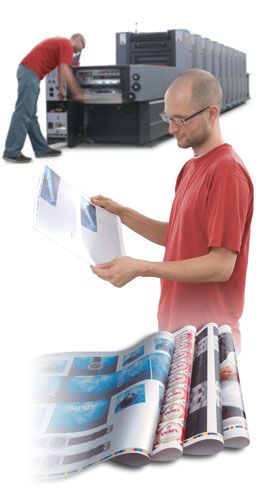Offset Printing Unit
Primary Areas of Offset Printing Unit
Printing unit includes inking and dampening models , home plate cylinder using the printing plate, the blanket cylinder using the blanket fixed into it, and also the impression cylinder.
Home plate cylinder using the inked printing plate will roll over the circumference from the blanket cylinder. The blanket cylinder, consequently, will roll over the circumference from the impression cylinder, which the piece of paper is
held by grippers. The contact line between your blanket cylinder and also the impression cylinder is known as the printing puppy nip.
Northern VA Printer
The printing plate - an as much as .3 mm thick sheet of metal or perhaps a foil - carries the look aspects of the particular color separation. The blanket is definitely an roughly 2 mm-thick, exchangeable cylinder cover produced from
flexible material and layers of material.
To make sure perfect change in paper image from plate to paper, the 3 cylinders must have a similar circumferential speed in the contact line/printing puppy nip.
The offset printing unit is driven through the impression cylinder using a gear train. The printing unit consequently sends the required drive energy for that inking unit.
An essential facet of gearwheel design is to maintain a variable spacing of cylinders, to ensure that certain operating conditions could be met (engaging and disengaging from the cylinders).When setting the paper
thickness, the variable spacing between blanket and impression cylinder shafts should be given particular consideration when likely to impression on.
For that proper change in ink between plate and blanket and between blanket and paper, a sufficiently high contact pressure between your cylinders along with the same circumferential speed from the cylinders is essential.
To regulate the contact pressure between plate cylinder and blanket cylinder, which move towards one another in a fixed axial clearance, home plate or even the
blankets they are under laid, a procedure which leads to b .05-.15 mm radial deformation from the blanket. The printing pressure between your blanket and also the impression cylinder is placed based on the character from the
substrate.
The gearwheel-drives produce slippage between your surfaces. The slippage implies that, additionally towards the radial deformation from the blanket within the contact zone, the cylinders also undergo tangential deformation. The
forces make the deformation from the blanket to die lower abruptly throughout the rotation from the cylinders at the beginning of the space and therefore are just like abruptly developed again once the cylinders enter into contact
again. This fluctuation from the contact pressure between zero and also the maximum value can also be known to as “cylinder gap shock.”
It causes oscillations within the printing unit which impair the printing result.
Bearer rings, also known as “cylinder bearers”, produced from hardened steel rich in moving strength are placed around the sides from the plate and blanket cylinders to reduce the result of the vibration. They're of roughly
exactly the same diameters because the working pitch diameters from the gears and roll upon each other at high initial tension. DC Printer
For that proper interaction of plate, blanket and impression cylinders it is crucial they link to one another to ensure that no relative motion
happens inside a circumferential or radial direction, that's, very little vibration as you possibly can is created. Thus the cylinders need to be fixed to one another having a minimum of oscillation. Therefore, the structural style of
cylinder bearing and printing unit frames assumes considerable importance.
For those three cylinders the bearing devices should be dimensioned for top forces. Furthermore, to make sure a precise ink transfer, the cylinders should be very rigid and rotate with zero backlashes.
Because of the diagonal register adjustment, home plate cylinder should also permit an angular adjust-ability from the bearings and also the blanket cylinder bearing must permit complex switching motions.
The cylinders using their bearings are supported between two vertical side
frames that are mainly produced from high-quality casting material. Alongside supporting the cylinders, the press frame has got the task of absorbing the forces and torque that occur throughout operation from the printing unit.
You will find many components that move against each other inside a printing unit. Within the interests of continuous functional performance and also the service existence of those components, sufficient lube is important.
The bearings and gears, particularly, place high demands around the lubricant. From the technical perspective, oil lube is easily the most appropriate. However, leakage can generate problems. Therefore, for presses of small- to
medium-sized formats liquid grease can also be used.



